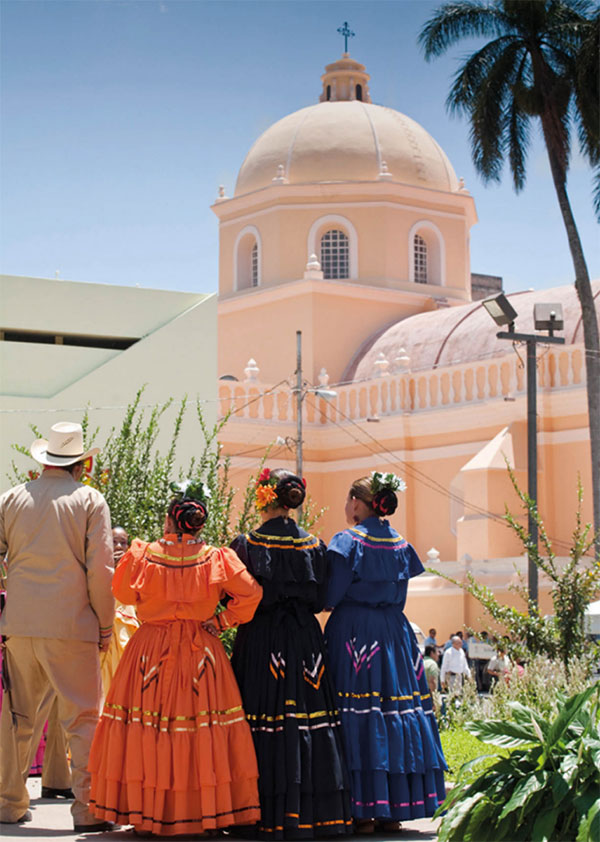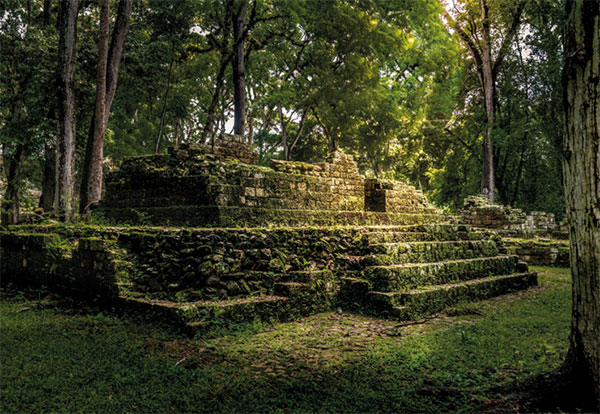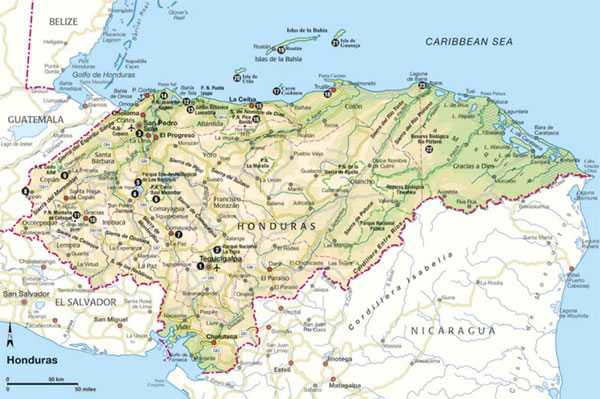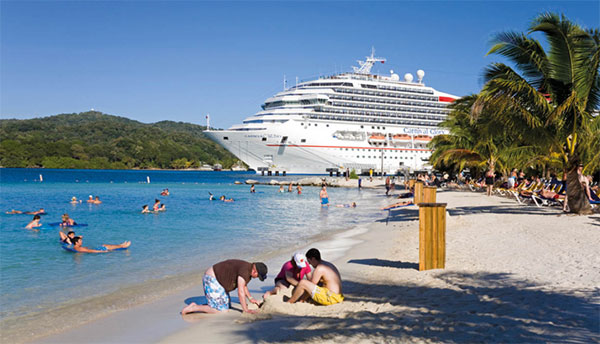HONDURAS
Rainforests, cloud forests, beaches, jungles, lakes, islands, Mayan ruins, colonial cities, and buzzing metropolises come together in Central America’s least discovered country.
Main Attractions
The Bay Islands
Pico Bonito National Park
Comayagua
Cayos Cochinos
Tela
Lago Yojoa
Gracias
Copán
Despite its large size – its 111,369 sq km (42,999 sq miles) make it second only to Nicaragua in the region – Honduras remains a mystery to many travelers to Central America. Political instability and high crime in recent years has steered what were promising investments in tourism off course, leaving the fate of many projects in the air. Still, no country in the region has more potential.

The Baroque cathedral in Parque Morazán, Tegucigalpa.
AWL Images
This is a country with a profound wealth of fascinating destinations. What it lacks in volcanoes, it makes up for in pine-covered mountains and lush cloud forests, 965km (600 miles) of coastline dotted with resorts and Garífuna villages, and a mini-Amazon with impenetrable jungles.
The sprawling cities of Tegucigalpa, the capital, and San Pedro Sula, the commercial center, are the main points of entry into the country and are home to fine museums and bustling nightlife. They demand no more than brief stops in transit, as to appreciate real Honduras requires you to get away from the often chaotic, sometimes dangerous centers of population.
Most tourism is concentrated in the Bay Islands of Roatán, Utila, and Guanaja, three idyllic little English-speaking Caribbean isles with some of the world’s best – and most inexpensive – diving. They are a place where escaped slaves, pirates, and now a growing number of expats have created a distinct cultural makeup. The North Coast, with its wildlife-rich national parks like Pico Bonito, Spanish forts, and family friendly beach resorts is a close runner up, attracting adventure sports enthusiasts, bird-watchers and a growing number of North American retirees.
In the interior, there’s the ancient city of Copán, perhaps the most spectacular Mayan ceremonial city in all of Mesoamerica, and the majestic Lago de Yojoa, flanked by two different national parks. Not far away is Comayagua, one of the region’s best preserved colonial cities, and sleepy Gracias, once the capital of Central America and now a jumping off point to explore a string of Lenca villages. Lastly, there’s La Mosquitia, where the thick jungle hides raging rivers, Indigenous communities, and the remains of a mysterious civilization that’s slowly being revealed.

Copán.
iStock

The modern economy
Carlos Roberto Flores Facussé became president in 1988 and initiated wide-scale currency reforms to slow the rapid inflation that was sinking the value of the lempira against the dollar. After decades of instability, things were beginning to look up, until Hurricane Mitch, the most powerful Atlantic storm ever recorded at the time, came along in October 1998 and caused billions of dollars’ worth of damage. More than 6,000 people were killed and 1.5 million displaced in the aftermath. The following years were spent trying to get the country back on its feet and repairing much of the damage. Even today the country’s infrastructure still has not fully recovered.
US INTERVENTION
While Honduras somehow avoided political upheaval like its neighbors in the second half of the 20th century, the US military used it as a base for the counter-insurgency movement against the Sandinistas in Nicaragua. Aid was provided to Honduras in exchange for space to train and equip the Contras, though many Hondurans were displeased. Mass protests against the US military broke out, and even as the Honduran military responded by kidnapping and killing protestors, they didn’t lose momentum. In 1988, after it was revealed that the Reagan administration had sold arms to Iran to support the Contras, the government ended its military agreement with the US. By the time the Contra war ended in 1990, the Contras were already gone from the country.
In 2006, Olancho rancher Manuel Zelaya Rosales was elected president on a platform of doubling the police force and lowering gas prices. The Central America and Dominican Republic Free Trade Agreement (CAFTA-DR) went into effect not long after, which led to increasing costs for food and energy. Zelaya turned to controversial Venezuelan President Hugo Chavez for help, allowing him to make modest economic and social reforms, like nearly doubling the monthly minimum wage from $157 to $289 and resolving longstanding land conflicts between farmers and agribusinesses. However, his reforms didn’t always go over well, as many factory owners could no longer afford to pay their employees and laid them off.
Honduras today
Despite low approval ratings, Zelaya called a referendum to reform the constitution and allow presidents to stand for re-election. On June 28, 2009, a few days before the vote was to take place, the army forced him on a plane, still in his pajamas, and took him to Costa Rica. Amid mass protests, a five-month curfew imposed by the new government cost the economy $50 million a day. In the weeks following the coup, Zelaya made three attempts to re-enter the country, but was stopped each time. New elections, boycotted by much of the country and many opposition candidates, took place that November. The right-wing National Party’s Pepe Lobo Sosa took office in January 2010, initiating a series of mining, logging, and agri-business projects, to the dismay of environmentalists.

Cruise ship docked at the Mohogany Bay Cruise Center.
Getty Images
Where
To the southwest of Tegucigalpa, across the Río Choluteca, is the neighborhood of Comayagüela, which doubled the size of the capital when the cities merged in 1938. While there are still some interesting colonial buildings here, mostly neglected, plus some of the city’s bus terminals, this area can be unsafe and should mostly be avoided.
The coup set the country on a downward spiral from which it is still trying to recover. Wages have dropped, public education and social security systems were destroyed, and tourism took a nosedive. Organized crime began taking advantage of weak institutions. The murder rate surged and by 2010, Honduras had become the world’s most violent country outside of a war zone. The drug trade flourished and it is estimated that 80 percent of cocaine-smuggling flights bound for the US passed through Honduras.
Elected in 2013 as president, and serving until 2022, Juan Orlando Hernández pushed forward with an overhaul of the country’s political system, creating a new militarized police force and installing figures loyal to his party in the supreme court and congress. However, violent crime and government corruption remained serious problems in the country and in 2022 Hernández had his visa for the US revoked after accusations of involvement in corruption and the drug trade. In January of the same year liberal candidate Xiomara Castro became the first female president of Honduras.
While development has been uneven at best and Honduras is not going to become the next Costa Rica anytime soon, there’s some hope in the air.